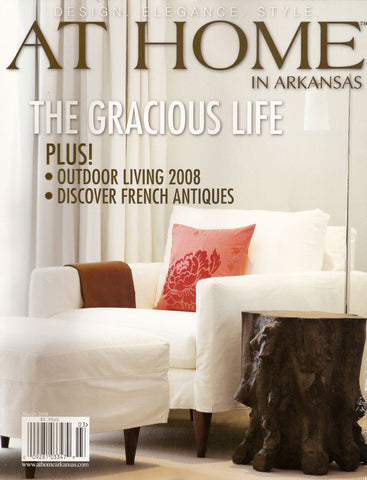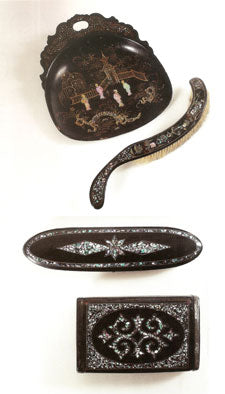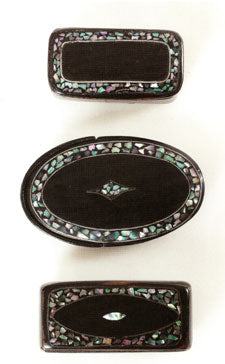- Continue Shopping
- Your cart is empty
At Home in Arkansas, November 2009
Reprinted courtesy of At Home in Arkansas

STYLE | REDISCOVERIES
by Paulette Pearson, associate editor
photography by Nancy Nolan/styling by Mandy Keener
LIKE MOTHER, LIKE DAUGHTER
A French antiques importer and her daughter share a rare collection of antique papier mache pieces with mother-of-pearl inlay.
It comes as no surprise that Renee Hunt, owner of French Metro Antiques in Fayetteville, likes to collect antiques, but onecollection that is especially dear to her is the growing assortment of French papier mache pieces that she shares with her 14-year-old daughter, Camille. "I have other favorites, but always planned for this one to be Camille's," Renee explains. "I wanted her to have a memory of mother going to France to purchase antiques."
Renee received the first piece, a crumber used to clean a linen rablecloth after meals, as a gift from a client, "a very Southern woman from New Orleans," Renee remembers. "Then I began looking for them on buying trips and eventually I didn't want to put them in the store to sell." Camille was a little girl at the time, but already showed an interest, and the mother-and-daughter duo has since amassed 14 beautifully preserved pieces, all found near Paris during visits to France.


However, their rarity means that Renee doesn't find one on every trip. Used in France beginning in 1850, during the reign of Napoelon III, papier mache allowed artisans to shape smaller objects not by carving or cutting but by molding. Translated as "chewed up paper," it consists of paper paste with a strong glue binder, meaning the material is very fragile. Furthermore, their delicate hinges and mother-of-pearl inlay are easily broken with neglect or heavy use. "We like our boxes to have working hinges," Camille explains. Making their collection especially rare, every piece also has intact abalone-colored mother-of-pearl and even maintains a shiny lacquer finish.
In addition, Renee and Camille are particular about what shapes they add to their collection. Camille will often ask her mother to keep an eye out for a certain style; last year, she requested an oval box when she noticed that they were lacking one. "Camille said, 'Mom, we need ovals,' and on that very trip I found two. I couldn't believe it," laughs Renee. Some of their other rare shapes include a case for folding glasses, which is Camille's favorite, as well as a box for playing cards, which Renee says is rare because of how much it must have been used. "In the late 19th century, playing cards was very common, so many of these card boxes didn't survive," she explains.

Rounding out Renee and Camille's collection are a pencil box with comparments for fountain pen nibs, powder boxes, a napkin ring, wine coaster, snuff boxes and several jewelry boxes. For now, all of them sit safely on the vanity in Renee's bedroom, holding special pieces of jewelry and other trinkets. Renee hopes that one day, years from now, Camille will look back and associate each box with her mother's jewelry, and remember the fun they had collecting them together. "I'm just very lucky that I have a daughter who likes to do this," Renee says.




